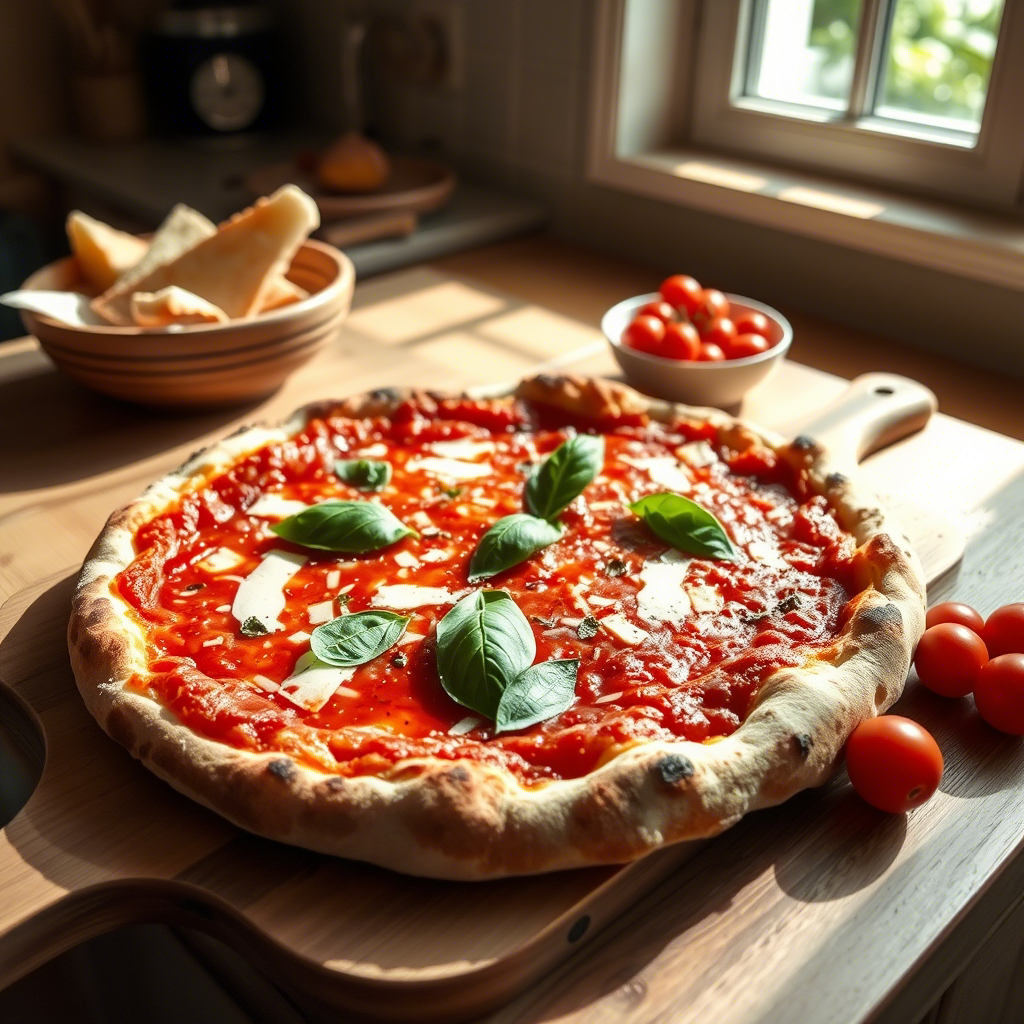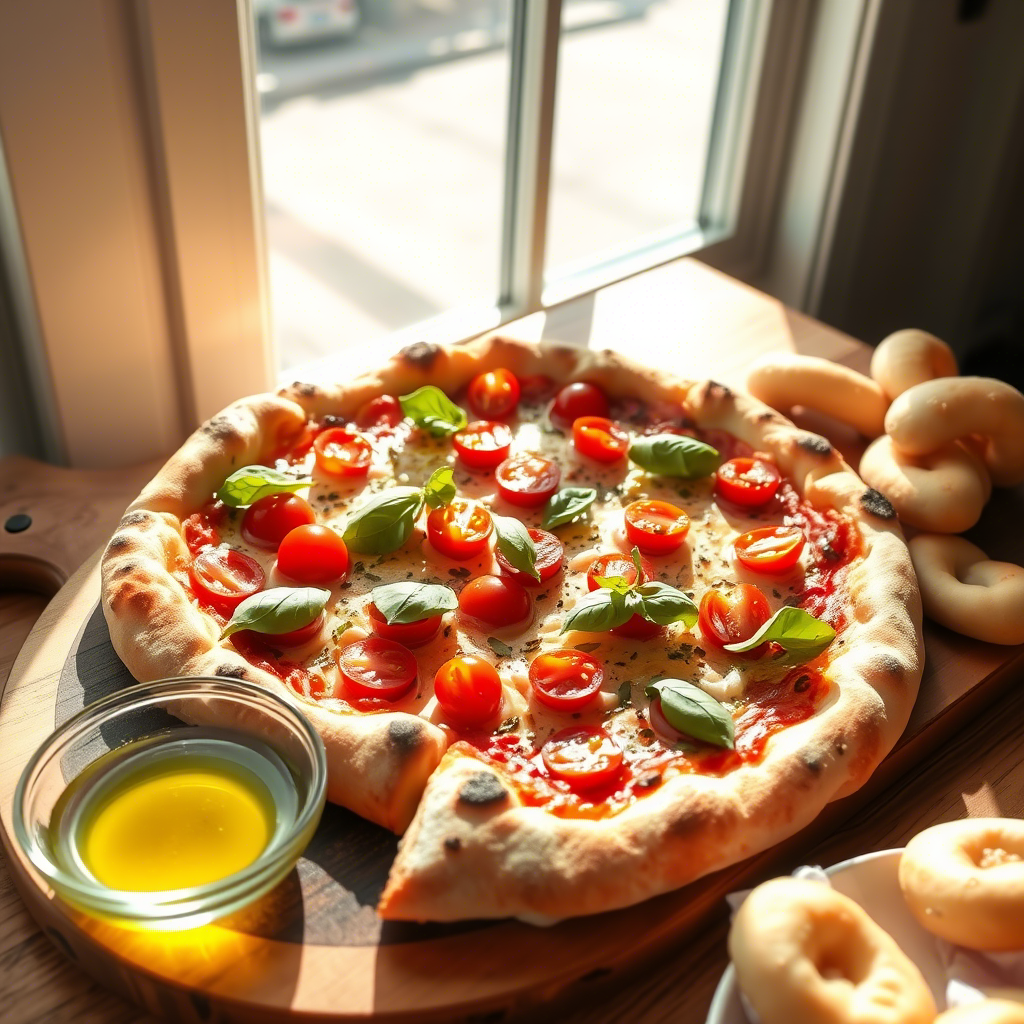Introduction
Have you ever wondered why the pizza sauce at your favorite Italian restaurant tastes so incredibly different from the jarred sauce you use at home? The answer might surprise you – authentic Italian pizza sauce isn’t about complex ingredients or long cooking times. In fact, the best Italian pizzerias often use an uncooked sauce with just a handful of high-quality ingredients! This revelation changed my pizza-making forever, and with this simple 5-ingredient Ooni pizza sauce recipe, you’ll discover how easy it is to create that genuine Italian flavor that makes pizza so irresistible.

Overview
This Ooni pizza sauce recipe stands out because it follows the traditional Italian philosophy of “less is more.” Unlike many commercial sauces loaded with sugar, preservatives, and a long list of seasonings, this authentic recipe lets the natural flavor of tomatoes shine through. Italian pizza makers (pizzaiolos) have perfected this approach over generations, and now you can bring that same authenticity to your home kitchen.
What Makes This Recipe Special:
- Uses only 5 high-quality ingredients
- No cooking required (yes, really!)
- Perfect balance of natural sweetness and acidity
- Specifically designed to complement the high heat of an Ooni pizza oven
- Authentic Italian method used by professional pizzerias
- Brings out the smoky flavors of wood-fired cooking
Time Required: Just 10 minutes active preparation Difficulty Level: Very Easy (perfect for beginners!) Yield: Sauce for 4-6 medium pizzas (approximately 2 cups)
The beauty of this recipe is that it takes almost no time to make, yet delivers restaurant-quality results. You can prepare it while your Ooni oven is heating up, or make it ahead of time for even better flavor development. The simplicity also means fewer chances for things to go wrong – it’s nearly foolproof!
Essential Ingredients
The secret to authentic Italian pizza sauce lies in the quality of ingredients rather than quantity. Here are the 5 essential components that will transform your homemade pizzas:
1. San Marzano Tomatoes (1 28-ounce can)
San Marzano tomatoes are the crown jewel of pizza sauce. These special plum tomatoes grown in the volcanic soil near Naples, Italy have:
- Fewer seeds than regular tomatoes
- Thicker, meatier flesh
- Lower acidity and natural sweetness
- A perfect balance of sweetness and acidity
- Rich, clean tomato flavor
Why they’re important: San Marzanos create a naturally sweet sauce with deep tomato flavor without needing added sugar or long cooking times. Their thick flesh also gives your sauce the perfect consistency without becoming watery.
How to choose: Look for cans labeled “DOP” (Protected Designation of Origin), which guarantees authentic San Marzanos from Italy. They’ll cost a bit more, but the flavor difference is worth it.
Substitution: If you can’t find true San Marzano tomatoes, use the best-quality canned whole peeled plum tomatoes you can find. In a pinch, crushed tomatoes will work, but you’ll lose some of the texture that makes this sauce special.
2. Fresh Garlic (2 cloves)
Fresh garlic adds a gentle aromatic quality that deepens the sauce’s flavor without overpowering the tomatoes.
Why it’s important: Fresh garlic provides a background note that brings complexity to the sauce. When used raw in this sauce, it offers a pleasant bite that mellows when exposed to the intense heat of the Ooni oven.
How to choose: Look for firm garlic heads with tight skin. Avoid any with green sprouts (which can taste bitter) or soft spots.
Substitution: In a pinch, you can use 1/4 teaspoon of garlic powder, but the flavor will be quite different. Fresh is always better for this recipe.
3. Extra Virgin Olive Oil (1 tablespoon)
A good quality extra virgin olive oil adds richness and helps the flavors meld together beautifully.
Why it’s important: Olive oil carries flavor compounds and creates a silky texture in the sauce. It also helps the sauce spread evenly on the dough and prevents it from drying out in the hot oven.
How to choose: Use a good quality Italian or Spanish extra virgin olive oil with a fruity, slightly peppery flavor. Since this sauce is uncooked, you’ll really taste the olive oil.
Substitution: While no other oil will give the same Mediterranean flavor, a light olive oil will work if you don’t have extra virgin. Avoid heavily flavored oils that might overpower the tomatoes.
4. Sea Salt (1/2 teaspoon)
Salt is essential for bringing out the natural flavors of the tomatoes.
Why it’s important: Salt doesn’t just make food taste salty – it enhances other flavors and reduces bitterness. The right amount will make your tomatoes taste more like tomatoes.
How to choose: Sea salt or kosher salt is preferable to regular table salt, which can have a harsher flavor due to additives.
Substitution: Kosher salt works well too. Start with a little less as the crystals are larger. Avoid salt with added iodine if possible, as it can leave a slight metallic taste.
5. Fresh Basil (5-6 leaves)
Fresh basil adds a wonderful aromatic quality that’s quintessentially Italian.
Why it’s important: Basil and tomatoes are perfect partners. The herb adds a sweet, slightly peppery note with hints of mint and anise that complements the acid in tomatoes beautifully.
How to choose: Look for bright green leaves with no black spots or wilting. The leaves should be aromatic when you tear them slightly.
Substitution: If fresh basil isn’t available, you can use 1/2 teaspoon dried basil, though the flavor won’t be quite the same. In summer, try growing your own basil plant for the freshest flavor.
Optional additions: While keeping true to the simplicity of authentic Italian sauce, you might consider these optional additions:
- A pinch of red pepper flakes for heat
- A teaspoon of dried oregano for an herbal note
- A teaspoon of honey if your tomatoes are particularly acidic
Step-by-Step Instructions
Creating authentic Ooni pizza sauce is surprisingly easy. Follow these simple steps for perfect results every time:
Step 1: Prepare Your Work Area
Before you begin, gather all your ingredients and tools:
- Large mixing bowl
- Can opener
- Sharp knife and cutting board
- Measuring spoons
- Potato masher or clean hands for crushing tomatoes
- Storage container
Having everything ready makes this quick recipe even faster.
Step 2: Prepare Your Tomatoes
Open your can of San Marzano tomatoes and pour the entire contents (tomatoes and juice) into a large bowl. Using clean hands or a potato masher, gently crush the tomatoes until you reach your desired consistency.
Some people like a chunkier sauce with visible pieces of tomato, while others prefer it smoother. Both are authentic – it’s completely up to your preference!
Pro Tip: Don’t use a food processor or blender! This overworks the tomatoes, breaks down their structure, and can make your sauce watery and bitter. The gentle crushing by hand preserves the tomato’s natural texture and flavor.
Step 3: Add Fresh Garlic
Peel your garlic cloves and prepare them using one of these methods:
- Mince them very finely with a sharp knife
- Use a microplane grater to create a garlic paste
- Crush them in a garlic press
Add the prepared garlic to your crushed tomatoes and stir gently to distribute.
Pro Tip: Let your minced garlic sit for 5-10 minutes before adding it to the sauce. This allows its beneficial compounds to develop fully, enhancing both flavor and health benefits.
Step 4: Add Olive Oil
Pour one tablespoon of extra virgin olive oil into the mixture. The olive oil helps carry the flavors throughout the sauce and adds a subtle richness.
Pro Tip: Use a good quality olive oil since you’ll really taste it in this no-cook sauce. This is one place where a slightly more expensive ingredient makes a noticeable difference.
Step 5: Add Salt
Sprinkle in half a teaspoon of sea salt and stir it through the sauce. The salt will help bring out the natural sweetness of the tomatoes and balance their acidity.
Pro Tip: You can adjust the salt later after tasting, so start with this amount. Different brands of tomatoes have varying levels of saltiness already, so you might need more or less.
Step 6: Incorporate Fresh Basil
There are two approaches to adding basil, both authentic:
Method 1: Tear or roughly chop 5-6 fresh basil leaves and stir them into the sauce. This distributes the basil flavor throughout and gives your sauce pretty green flecks.
Method 2: Place 5-6 whole basil leaves into the sauce, let them infuse their flavor during the rest period, then remove them before using the sauce. This gives a more subtle basil flavor.
Pro Tip: Slap the basil leaves between your palms a few times before adding them. This bruises the leaves, releasing more of their essential oils and fragrance into your sauce.
Step 7: Mix Thoroughly and Let Rest
Stir all ingredients together well, making sure everything is evenly distributed. Then cover the bowl and let the sauce rest for at least 30 minutes at room temperature. For even better flavor, let it rest for 1-2 hours, or refrigerate for up to 24 hours before using.
During this resting time, magic happens – the salt draws moisture and flavor from the tomatoes, the garlic infuses throughout, and all the ingredients harmonize together.
Pro Tip: This sauce is traditionally used uncooked (called “salsa cruda”) for authentic Italian flavor, but if you prefer a deeper, more concentrated flavor, you can simmer it gently for 20-30 minutes. Just know that cooking will change the bright, fresh character that makes this sauce special.

Assembly
Using your Ooni pizza sauce correctly on your pizza will help you achieve spectacular results:
Step 1: Prepare Your Pizza Dough
Stretch your pizza dough to your desired thickness on a well-floured pizza peel. For best results with an Ooni oven, aim for a thickness of about 1/8 to 1/4 inch in the center.
Step 2: Apply the Sauce
Using a large spoon, place 2-3 tablespoons of sauce in the center of your dough. With the back of the spoon, spread the sauce in a circular motion from the center outward, leaving about 1/2 to 3/4 inch of crust around the edge.
The sauce should be spread thinly and evenly – you should be able to see faint traces of the dough through the sauce in most places.
Pro Tip: Less is more with authentic Italian pizza sauce! Use only 2-3 tablespoons for a 12-inch pizza. Too much sauce will make your pizza soggy, especially in the high heat of an Ooni oven where the bottom cooks quickly but excess moisture can’t evaporate fast enough.
Step 3: Add Toppings
Add your cheese and other toppings as desired. For the most authentic Italian experience, use fresh mozzarella torn into small pieces rather than pre-shredded cheese, and keep the toppings light – authentic Italian pizza isn’t overloaded with ingredients.
Step 4: Bake in Your Ooni Pizza Oven
Slide your pizza into your preheated Ooni oven and bake according to your oven’s instructions:
- For Ooni Koda or other gas models: About 60-90 seconds at 950°F (500°C)
- For Ooni Fyra or other wood pellet models: About 60-90 seconds at 950°F (500°C)
- For Ooni Pro or multi-fuel models: Time varies by fuel, but generally 60-90 seconds at max temperature
Keep a close eye on your pizza and rotate it every 20-30 seconds to ensure even cooking.
Presentation Tips:
- For a professional finishing touch, drizzle a little extra virgin olive oil over the finished pizza
- Add a few fresh basil leaves after the pizza comes out of the oven
- A light sprinkle of grated Parmesan or Pecorino Romano cheese adds a nice final note
- Serve immediately while the crust is still crispy and the sauce is hot
Storage and Make-Ahead Tips
This Ooni pizza sauce actually improves in flavor after it sits for a while, making it perfect for preparing ahead of time.
Refrigerator Storage:
- Store leftover sauce in an airtight glass or plastic container in the refrigerator for up to 5 days.
- Let the sauce come to room temperature before using for the best flavor.
- Stir well before using as natural separation may occur.
- If you notice any water separation, simply stir it back together – do not drain off the liquid as it contains flavor.
Freezer Storage:
- This sauce freezes beautifully for up to 3 months without losing quality.
- Freeze in ice cube trays for perfect single-pizza portions (2-3 cubes per pizza).
- Once frozen, transfer the cubes to a freezer-safe zip-top bag.
- Label with the date and contents.
- Thaw overnight in the refrigerator or at room temperature for a few hours before using.
Pro Tip: If you plan to freeze the sauce, you can add the fresh basil after thawing rather than before freezing for the brightest flavor. Alternatively, you can freeze the sauce in small containers with just enough for one pizza-making session.
Batch Preparation:
- This recipe scales up easily – simply multiply all ingredients by the same factor.
- For a big pizza party, make a double or triple batch a day ahead for maximum flavor and minimum day-of stress.
- If making a large batch, divide into smaller portions before storing for easier use.
Recipe Variations
While the classic 5-ingredient sauce is perfect on its own, here are some delicious variations to try once you’ve mastered the basic recipe:
1. Spicy Arrabbiata Pizza Sauce
Add 1/2 teaspoon of crushed red pepper flakes (or more to taste) for a sauce with a kick that pairs beautifully with spicy toppings like soppressata or hot Italian sausage.
2. Roasted Garlic Pizza Sauce
Replace fresh garlic with 1 head of roasted garlic for a sweeter, more mellow garlic flavor. To roast garlic: cut the top off a whole garlic head, drizzle with olive oil, wrap in foil, and bake at 400°F (200°C) for 30-40 minutes until soft and golden.
3. Herbed Pizza Sauce
Add 1 teaspoon of dried oregano, 1/2 teaspoon of dried thyme, and a pinch of dried rosemary along with the basil for an herbal sauce that works well with vegetable toppings.
4. Fire-Roasted Pizza Sauce
Use fire-roasted canned tomatoes instead of regular San Marzanos for a subtle smoky flavor that complements the wood-fired taste of an Ooni oven. This variation works particularly well with grilled vegetable toppings.
5. Vodka Pizza Sauce
Add 2 tablespoons of vodka and 3 tablespoons of heavy cream to the basic sauce recipe, then simmer for 10 minutes for a rich, creamy sauce. (This variation does require cooking.) The alcohol cooks off, leaving a unique depth of flavor that pairs wonderfully with prosciutto and arugula.
6. White Pizza Sauce Alternative
For a complete change of pace, skip the tomato sauce entirely and brush your dough with garlic-infused olive oil (1/4 cup olive oil steeped with 2 crushed garlic cloves for 30 minutes). Top with ricotta cheese, mozzarella, and your favorite toppings.
Conclusion
Creating authentic Italian pizza sauce for your Ooni pizza oven doesn’t have to be complicated. With just 5 high-quality ingredients and a few minutes of your time, you can make a sauce that rivals any pizzeria in Naples. The beauty of this recipe lies in its simplicity – it lets the natural flavors of fresh ingredients shine through, creating the perfect complement to your homemade pizza crust and the unique cooking environment of an Ooni oven.
Don’t be afraid to adjust the ingredients to suit your personal taste. Maybe you love a little more garlic, or perhaps you prefer adding a pinch of oregano. The best pizza sauce is the one that makes YOU happy. Italian cooking is all about feeling and personal preference, not rigid rules.
Remember that authentic Italian cooking is about respecting ingredients and letting their natural flavors speak. This sauce does exactly that – it enhances your pizza without overwhelming it.
Next time you fire up your Ooni pizza oven, skip the store-bought sauce and try this simple, authentic recipe instead. Your pizza (and your dinner guests) will thank you!

FAQs
Why doesn’t this pizza sauce need to be cooked?
Traditional Italian pizza sauce is often used raw (called “salsa cruda”) because the sauce cooks perfectly in the intense heat of a pizza oven. This preserves the fresh tomato flavor and prevents the sauce from becoming too reduced before going into the oven. The high temperature of the Ooni oven (around 950°F/500°C) cooks the sauce perfectly during the brief baking time.
Can I use fresh tomatoes instead of canned?
Yes, but the results will vary depending on the quality and ripeness of your tomatoes. If using fresh, choose very ripe Roma or plum tomatoes, blanch them in boiling water for 30 seconds, then peel and deseed them before crushing. You may need to add a pinch of sugar if they’re not naturally sweet. Remember that fresh tomatoes are more watery than canned, so your sauce might need to be drained slightly.
Is this sauce healthy?
Yes! This sauce is very healthy compared to commercial pizza sauces. It has:
No added sugar (commercial sauces often contain 3-4g per serving)
No preservatives or artificial ingredients
Rich amounts of lycopene from tomatoes (a powerful antioxidant linked to heart and prostate health)
Heart-healthy monounsaturated fats from olive oil
Garlic’s natural immune-boosting compounds
Fresh basil’s anti-inflammatory properties
A 2-tablespoon serving contains approximately 20 calories, making it a light addition to your pizza.
How much sauce should I use on my pizza?
For a 12-inch pizza, use only 2-3 tablespoons of sauce spread in a thin layer. Authentic Italian pizza has a light application of sauce, not a thick slathering. Too much sauce will create a soggy crust, especially in the intense heat of an Ooni oven.
Can I make this sauce in advance for a pizza party?
Absolutely! This sauce actually improves after sitting for a day as the flavors develop. Make it up to 3 days ahead and keep refrigerated until needed. For large gatherings, prepare a double or triple batch and portion it out for easier use during your party.
My sauce seems watery. What did I do wrong?
You may have overprocessed the tomatoes. Next time, crush them by hand or with a potato masher rather than using a blender or food processor. You can also drain some of the tomato juice before crushing if your tomatoes are particularly watery. Some separation is natural – just stir before using.
Can I use this sauce for pasta too?
While this sauce is designed for pizza, it can be used as a fresh pasta sauce, particularly for summer dishes. For pasta, you might want to simmer it for 15-20 minutes to concentrate the flavors and cook the garlic slightly. It’s especially good with fresh pasta shapes like orecchiette or farfalle and a sprinkle of good Parmesan cheese.
Do I need an Ooni pizza oven to use this sauce?
No! While this sauce works perfectly with the high heat of an Ooni oven, it’s also great for pizzas cooked on a pizza stone in a conventional oven (use the highest temperature your oven allows, typically 500-550°F/260-290°C) or even pan pizzas. You might need to spread it slightly thinner for lower-temperature cooking methods.
Why is my sauce bitter?
Bitterness usually comes from one of three sources: low-quality canned tomatoes (some have a metallic taste), overworked tomatoes (using a food processor), or old/sprouting garlic. Use high-quality canned tomatoes, crush them gently by hand, and make sure your garlic is fresh without any green sprouts in the center.
Can I add sugar to the sauce?
Traditional Italian pizza sauce doesn’t contain added sugar – the natural sweetness of good tomatoes should shine through. However, if your tomatoes are particularly acidic or you prefer a slightly sweeter sauce, you can add a teaspoon of honey or sugar. Taste your sauce first before deciding if it needs this addition.
Discover Quick & Fun Recipes on TikTok with ToDaRecipes
Looking for fast, visual inspiration to spice up your meals? At ToDaRecipes, we love sharing easy, creative, and delicious recipes that anyone can try at home—and TikTok is the perfect place to see them in action!
Whether you’re into juicy burgers, refreshing drinks, or sweet desserts, our TikTok videos show step-by-step instructions in under a minute. It’s the fastest way to get inspired and start cooking.
👉 Check out our TikTok here: ToDaRecipes on TikTok and follow us for bite-sized kitchen magic!
Explore trending food ideas, kitchen hacks, and recipe tutorials designed to make cooking fun and simple. Don’t just read the recipe—watch it come to life!












